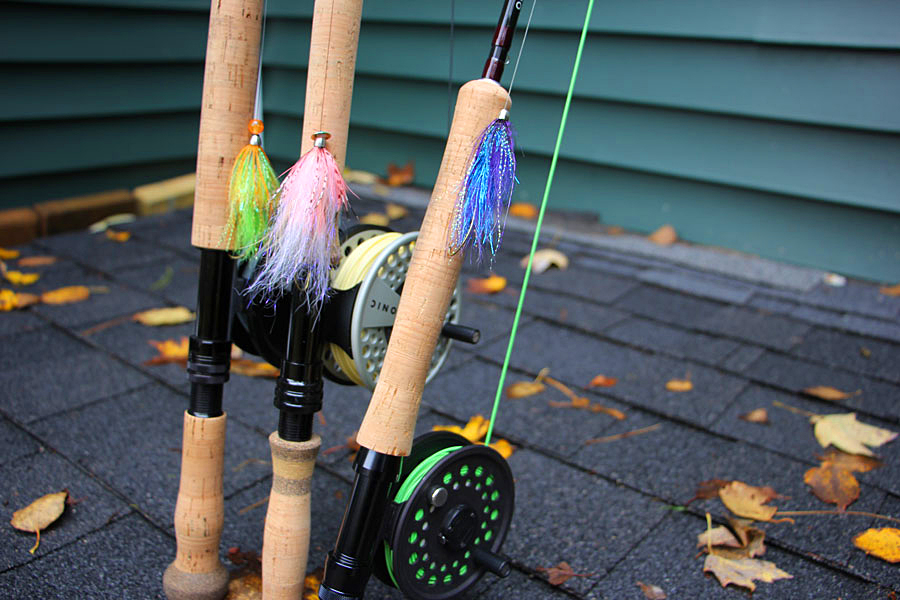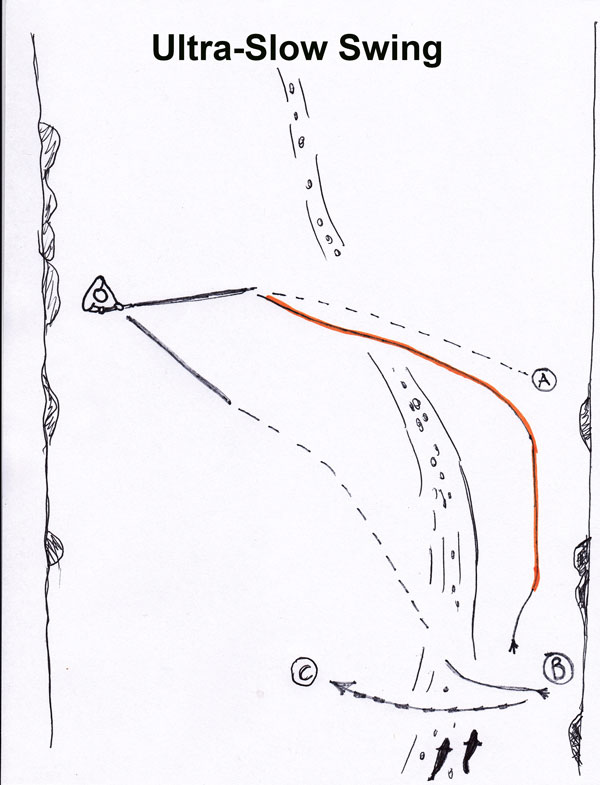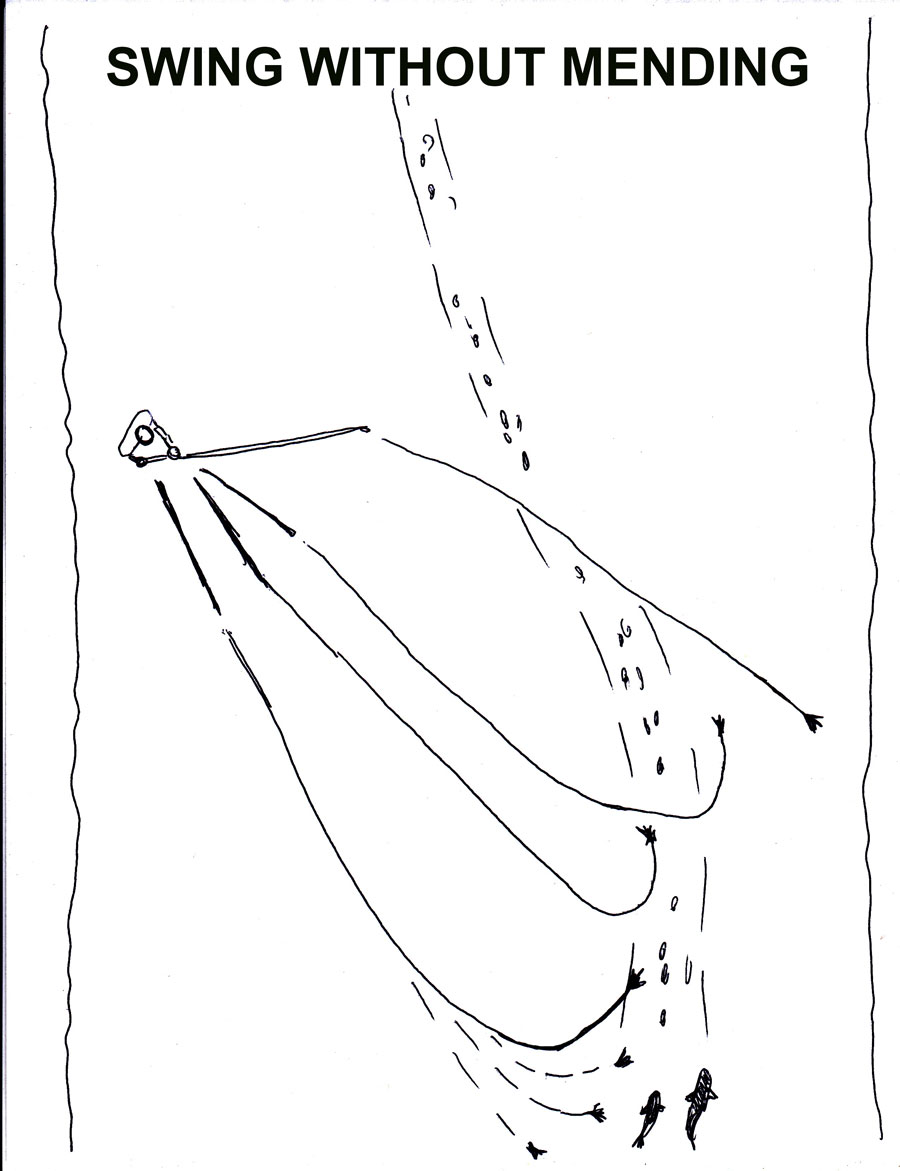I’ve been swinging flies for trout and steelhead for over 20-years – classic, winged-wet flies that have been catching trout for over a century in Europe and the United States. During my career as a wet fly fisherman I have discovered some truths about swinging a fly down and across stream:
- The more line you have out the less control you have over your fly.
- The difference between catching and not catching fish is having control over your fly as it swings.
As a newcomer to 2-handed rods I find a great advantage in my increased ability to cover water but also, knowing the difference line control can make, I feel there are many disadvantages that must be considered and overcome to successfully and consistently take fish on 2-handed rod at great distances.
Truth be told, any fool can catch a trout on the swing. I know, I’ve been that fool. A byproduct of fishing down and across is that no matter how poorly it’s done, at some point in the swing, the combination of tension and current velocity will correct the errors in a presentation and properly present a fly for a brief moment. Cast and swing often enough, and eventually the “blind pig in a forest” theory will reward you with a heart racing, tight line hook up.
I am also convinced that the result of this phenomenon is the reason so little has been written about down and across presentation. Hell, even in Dave Hughes’ Wet Flies: Tying and Fishing Soft-Hackles, Winged and Wingless Wets, and Fuzzy Nymphs (the most masterful work on wet fly fishing) there are less than seven pages of text on the down and across presentation. While Jock Scott’s “Greased Line Fishing for Salmon” is perhaps the most detailed journal on down and across presentation, it is primarily dedicated to one of many presentation tactics for fishing on the swing.
The nuances of swinging a fly are too great to summarize in a single blog entry, however there are mechanics that every down-and-across fly angler should consider to improve their swing to catch more fish consistently.
CURRENT SPEED IS MULTI-DIRECTIONAL
Not only does current speed vary across a river (horizontal from bank-to-bank), the velocity varies from the surface to river bottom in the vertical water column. As a rule of thumb, and result of friction, the velocity of surface water will always be greater than the velocity of water near the river bottom — with the fastest current just below the river surface at center current and the deepest current as much as 50% slower. When dredging with sink tips and weighted-flies, the angler should always be aware that the deeper a fly goes the slower it travels – while the fly line on or near the surface continues to travel at higher velocities. The longer a fly swings and the deeper it goes, the greater the opportunity for the sink tips and leader to run ahead of the fly.
The result of an un-manipulated swing will result in the leader and sink-tip running ahead of the fly – until which point line tension begins to straighten the leader and lift the fly from the bottom.
If you have ever hooked a fish, far to the side and upstream of the tip of your floating fly line, you know how water speed can change your presentation. If you want to watch this phenomenon in action – just browse the countless, wonderful steelhead videos on VIMEO and concentrate on where they are hooking up fish.
The water column is a three dimensional space. When fishing on the swing, your leader not only curves to the side but also curves top to bottom in the water column. To visualize what happens to a swung fly – first, imagine nymph fishing, where the bobber floats downstream faster than the sunken fly. This is because surface water is moving faster so the fly is “curling” the leader upstream. When you add swing to the presentation, a deep-sunken, slow-moving fly has no choice, as a result of physics, to travel upstream and behind your curved leader and sink tip.
Unless corrected at the onset of the cast (and throughout very slow swings), you can be assured that a “skewed D-loop” of sink tip and leader will smack holding fish in the nose, long before your fly reaches them – or until the tension is introduced and drag begins to begins to straighten that un-manipulated mess out. This correction automatically occurs in the “hot zone” of the swing- down and across stream, somewhere between 4 and 5 o’clock (if we consider 6 o’clock directly below the angler).
The hot zone of the swing is hot simply because this is when the fly has an opportunity to get ahead of the leader and sink tip again (before it rises to the surface) – fixing all the problems the current creates before it gets there – thus, fishing very well from that point of the swing to the dangle (directly below the angler at 6 o’clock).
The difference between advanced wet-fly fishing and the sling-it-and-swing-it method, is advanced line control that allows you present a fly properly at any angle downstream – at any level in the water column you wish.
To further understand the complexities of current velocities in the water column and the effect it has on fish and fishing, I highly recommend every fly angler (especially sub surface spey anglers) read Jason Randall’s Moving Water; A Fly Fishers Guide to Currents. The book is an invaluable resource to understanding what happens to your fly and line once it disappears below the surface of the water.
MENDING
Mending, pure and simple, is line manipulation. It is used to control the speed of the swing. Fly line can follow a fly with little to no tension and reduce the speed of the fly, or lead it and increase the speed as drag is introduced.
Keeping line directly above a fly will present a slow swing, and line that is to the side or below the fly will speed the swing.
What is important to the subsurface Spey angler is, obviously, you cannot mend line once it is below the surface. The window of opportunity to manipulate a sink tip before it begins to sink is a limited. To make matters more difficult, trying to use low-density running line to re-position a 500+-grain Scandi or Skagit head is a monumental affair.
Successful line control begins with a cast that turns over a straight leader. Often times, especially when shooting line and heavily weighted flies, it is all too common and easy to pile the leader on the water. Lifting the rod tip after a cast, will straighten the line and leader. Lower the rod tip as the as the line begins to move and allow the sinking fly to slightly “stick,” then use the added friction to your advantage as you mend your line above the fly.
Keep in mind the initial part of a deep swing is all preparation – getting the fly down to the desired depth before tension is applied and the fly is “swung” past holding fish.
Feeding line into a cast will allow the fly to sink deep. Mending additional line, on the backside of the fly (in the softest water on the far bank) will allow a fly to sink even deeper. After line is mended, following the line with the rod tip will help relieve tension that would induce drag and lift or speed the fly.
TENSION
Tension is the art of the swing. When and how you apply tension in the swing determines how the leader straightens and when it swims the fly in the water.
Essentially, tension is akin to “putting on the breaks.” When you add tension to fly line, the line stops moving freely with the current and drag is introduced to the swing. During the initial moments drag is introduced, the leader will begin to straighten below the line, and then lift the fly and line to the surface.
In the common sling-it-and-swing-it method, the angler casts down and across (quartering downstream) then follows the line with the rod tip until it reaches the apex of the swing and tension is applied as a result of the current pulling against the line. The angler then lets the current straighten the leader and the fly swings across stream and to the surface until it dangles below the angler.
Again, this method works but the “fishable area” of the swing is reduced to a very small window. Line manipulation can increase the fishable area of a swing and improve the catch rate – simply because the fly spends more time fishing than sinking improperly.
MENDING FOR AN ACCURATELY PLACED SLOW SWING: Diagram
Cast to point A (beyond the foam line to slower water) and make and immediate upstream mend. Continue to peel line and mend directly above (and slightly behind) the fly until it reaches point B — while keeping line out of the faster moving water. When the fly reaches point B and is sunk to the desired depth, lift the rod tip and introduce tension/drag and follow the swing across the current with your rod tip to point C and then dangle.
SPEY SWING WITHOUT MENDING
To easily understand how horribly wrong things can go with a sink tip, simply cast a dry fly and floating fly line down and across stream. Observe how the fly and line drags when it is not manipulated in any way. Now, imagine the same swing using a fly that is dragging a windsock behind it — which slows the speed of the fly as much as 50%. The drag from the windsock is essentially what happens to a weighted fly and sink tip when it enters the lowest portions of the water column. The end result of an spey swing with a full or partial sink tip is illustrated below.





